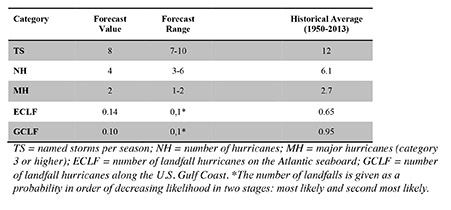HUGO team at CCU releases hurricane outlook for 2015
According to the HUGO outlook (detailed in the table above), the most likely scenario is that no hurricanes will make landfall on either the U.S. East Coast or the U.S. Gulf Coast during the 2015 hurricane season (June 1 to Nov. 30); the second most likely scenario is that one hurricane will make landfall on either the U.S. East Coast or the Gulf Coast; and the third most likely possibility is that one hurricane each will make landfall on the U.S. East Coast and the Gulf Coast.
The outlook predicts that there will be a range of 7 to 10 (with 8 most likely) named tropical storms, 3 to 6 (with 4 most likely) hurricanes and 1 to 2 (with 2 most likely) major hurricanes this season. Updated outlooks will be released during the hurricane season in June, July and August 2015; as more observational climate data become available.
Last year's CCU HUGO outlook forecast was highly successful. Its forecast range for the number of U.S. Atlantic Ocean Basin coastline landfalls was between zero and two, and the actual number of landfalls was one.
The HUGO team refined its outlook and landfall forecast capabilities for the 2015 season.
The HUGO Hurricane Landfall Outlook Program is a unique hurricane model system developed by scientists at Coastal Carolina University and unveiled in 2013. The new model differs from most other hurricane prediction instruments in that it offers hurricane number landfall probability information. In addition to the seasonal outlook, the model system will predict the track and intensity and the spatial and temporal local coastal surge, inundation and flooding information of any incoming hurricane five days away from landfall.
The HUGO hurricane seasonal outlook model is based on calculations of 22 climatological factors encompassing oceanic, atmospheric and shoreline activity. The model also considers detailed statistical data from previous Atlantic hurricanes going back to 1950, a methodology that has produced highly accurate track predictions in hind-casting tests conducted by the team at CCU. The HUGO team has made a major advance in computing a key factor in advance of an upcoming season, the Accumulated Cyclone Energy (ACE) Index, which calculates the kinetic energy of storms based on the summation of all tropical storm wind values, observed over an entire hurricane season.
Also, because the HUGO model system provides specific data on probable storm surge and inundation as a hurricane approaches, including time, location and statistical representations of expected water depth along the coastline, it is expected to have special relevance for emergency management officials in their logistical planning in the event of evacuations.
HUGO outlook reports are updated periodically during the season as new observational data becomes available from the Atlantic and Pacific Ocean Basins by way of NOAA and other federal agencies, such as the National Aeronautics & Space Administration.
The end-to-end HUGO model system was developed by a group of climatological and weather scholars of international standing led by Len Pietrafesa, former chair of the National Oceanic & Atmospheric Administration (NOAA) Science Advisory Board and of the National Hurricane Center External Advisory Panel and now a Burroughs & Chapin Scholar on the faculty of CCU's School of Coastal and Marine Systems Science (SCMSS). Other members of the CCU team are Shaowu Bao, a computational, deterministic numerical modeler specializing in meteorology and oceanography and a professor in SCMSS at CCU; Tingzhuang Yan, a meteorological oceanographer with a background in statistical modeling of climate and weather systems and a Burroughs & Chapin Research Scholar in SCMSS at CCU; and Paul Gayes, longtime CCU professor and director of SCMSS.
The Hurricane Seasonal Outlook is a greatly advanced version of the model system developed in the Ph.D. dissertation of Yan in 2006 at North Carolina State University, and funded through a grant from the NOAA Coastal Services Center in Charleston, the National Research Council and the NOAA National Centers for Environmental Prediction. The individual hurricane track and intensification and landfall surge and flooding model system is based on the interactively coupled model system developed by Bao and Pietrafesa under prior NOAA funding through the NOAA Coastal Services Center in Charleston.
For more information about CCU's HUGO Project, contact Pietrafesa at 843-349-4017 or 704-910-7047 or email lpietraf@coastal.edu. The HUGO Project website is at bcmw.coastal.edu.



